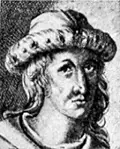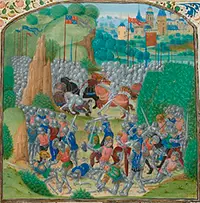King Robert III of Scotland
Robert III was King of Scotland for 16 years during the end of the 14th Century and the beginning of the 15th Century. He struggled with claims of infirmity and illegitimacy and, for much of his reign, was not really in charge. 
He was born on Aug. 4, 1337. His father was King David II, and his mother was Elizabeth Mure, whom Robert had not married until after all the children were born. Robert and Elizabeth were married in 1349. Because the children were born when their parents were not married, many nobles considered the children not fit for succeeding their father on the throne. Nonetheless, Robert declared that his firstborn son, John, was his heir apparent. Because of perceived weakness at his inability to control John's brother Alexander, the Scottish council in 1384 stripped the king of his power and put John in charge. He served in that capacity for another four years. He was crippled in a riding accident and then was passed over for the national lieutenancy in favor of another brother, Robert of Fife. Their father died in 1390. John was still the firstborn son, and so he succeeded his father on the throne. He took as his king name not King John II but King Robert III, saying that he did not want to associate himself with the first king of that name, King John Balliol, whom many saw as too dependent on England. The new queen was John's wife, Annabella Drummond. They had married in 1366 and had seven children in all. Their first son, Robert, died when he was very young. Their second son, David, came along in 1378; a third son, James, was born in 1394. 
One highlight in the 14th Century struggles between England and Scotland was the Scottish victory in 1388 at the Battle of Otterburn. This victory, near Newcastle, was at the expense of Northumberland's Henry Percy, known as "Hotspur." Leading the Scottish forces was James, Earl of Douglas, who died in the fighting. Douglas had been Carrick's main supporter, and the king's eldest, crippled from a fall from a horse, lost enough other support that he was replaced as the effective head of the country by his younger brother Robert, Earl of Fife. Fife retained this title and this responsibility even as his father and then his brother were on the throne. This changed in 1393, when the ruling council restored the king's power; Robert then ruled in his own name, in conjunction with his son David. Robert, for most of his life prone to illness, struggled mightily again in 1399 and was again stripped of his power; David carried on as regent. David and Robert of Fife clashed in 1401, and the latter imprisoned the former, who died in captivity. In that same year, English forces invaded Scotland, scoring victories in the Battle of Nesbit Moor and the Battle of Humbleton Hill and occupying Edinburgh. Four years later, King Robert III became convinced that his brother had it in for his remaining son and so had young James spirited away to France. Robert of Fife, learning of the plan, sent a force to intercept the escaping heir apparent. James and a few of his supporters escaped to Bass Rock, in the Firth of Forth, where they survived for a month until a ship from France arrived. English pirates intercepted the ship and handed the young king-to-be over to England's King Henry IV. James spent 18 years as the king's prisoner. Hearing of his remaining son's misfortune, Robert the king became despondent and refused to eat. He died not long afterward, on April 4, 1406. Because James was not there to succeed his father, the Scottish Parliament cemented Robert of Fife's status as Regent of Scotland. James did eventually return and became King James I. |
|
Social Studies for Kids
copyright 2002–2024
David White




